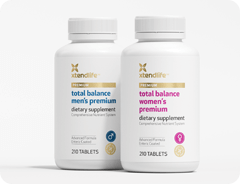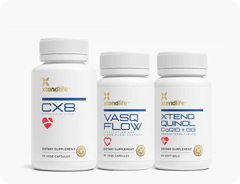Linked in a wide variety of studies to smarter kids with more focus, better heart health, less risk of joint problems and a lower risk of mood and brain disorders, it’s no wonder Omega 3s get so much attention. (Ref. 1)
But that’s not to say Omega 3s aren’t a smorgasbord of confusion.
There’s DHA and EPA – the most studied and the most potent of the Omega 3s - as well as DPA and ALA, creating a perplexing landscape for anyone looking to learn more about the essential fatty acids.
DHA and EPA first gained attention in the 1970s, during a time when all fat was seen as bad, when Danish researchers began comparing the diets of Inuit people in Greenland, who experienced virtually no heart diseases, with the diets of Americans, where fat was being consumed less but heart disease was skyrocketing.
The researchers linked the EPA and DHA in the fish and seals that made up the bulk of the Inuit diet with the lower risk of heart conditions, and in doing so, inspired more scientists to look at the beneficial qualities of the Omega 3s in fish oil and other components, and has led to the idea of good fats versus bad.
DHA for brain health
If you had to select one Omega 3 as the star of the show, it would be DHA.
Essential for brain health – especially so in developing infants and children – DHA, known as docosahexaenoic acid, is a long-chain fatty acid (it has 22 carbon bonds) that takes some cues from the realm of sci-fi, since it can shape shift and connect to other important molecules to help them work more effectively.
DHA is the primary structural component of the human brain, and it is key to the flow of nerve impulses that make up our consciousness, suggesting the link between a deficiency of DHA and Alzheimer’s.
Found naturally in breast milk – especially in mothers who make sure to get enough Omega 3s in their own diets – DHA is found and stored in every cell of our bodies, making it an essential nutrient for overall health.
Our line of Omega 3 fish oils – Omega 3/DHA Fish Oil, Omega 3 / DHA Plus and Omega 3 / QH Premium CoQ10 – contain excellent levels of DHA, ensuring you’ll get a healthy daily dose of the most valuable of the Omega 3 fatty acids.
EPA for healthy cells
EPA – also known as eicosapentaenoic acid – helps prevent damage to cells by helping your body’s healthy inflammation management, which may reduce the likelihood of degenerative conditions.
EPA appears to do this by inhibiting an enzyme that encourages the production of arachidonic acid, which triggers inflammation. DHA – with its 22 carbon bonds – appears to be to large to squeeze into the site where the enzyme is active, but EPA only has 20 carbon bonds, so it can enter the area more effectively. (Ref. 2)
The body can, however, convert DHA to EPA by dropping two carbon atoms, so if EPA is lacking, DHA can essentially step in to fill the void.
EPA may also help your body manage cellular inflammation in the brain, but since it is quickly oxidized, it is important to maintain high levels of the Omega 3 fatty acid in the bloodstream to ensure there is enough for the brain to use.
DPA: The lesser-known Omega 3
While DPA, or docosapentaenoic acid, isn’t as well known as the other Omega 3 fatty acids it is often paired with, it is starting to get more attention, especially for its role in skeletal, heart and kidney health.
This fatty acid may help prevent the aggregation of platelets, so blood flows smoothly through vessels and is less likely to clot or cling to the sides of arteries, leading to clogging or sluggish blood flow.
Formed in the pathway between DHA and EPA, DPA is the same size as DHA, with 22 carbon bonds, and like DHA, it can also be converted to EPA.
Some studies have also linked DPA to quicker healing, as well as the formation of new blood vessels. (Ref. 4)
ALA: The plant based Omega 3
Alpha linolenic acid, better known as ALA, is a valuable Omega 3 found in plant sources such as flax seed, walnuts and chia seeds as well as vegetable oils such as soy and canola, as well as green veggies including Brussels sprouts, kale and spinach. ALA is often the Omega 3 touted on food labels. (Ref. 3)
About 20 percent of the ALA we take in is converted to EPA, while between one and nine percent are converted to DHA in a healthy young adult. Older adults may not convert any of it to DHA, which further increases the desirability of supplementing with real fish oil.
DHA: The most important Omega 3
As mentioned earlier, of all the Omega 3s, DHA is by far the most important. Our Xtend-Life fish oil products have more DHA than most of the other fish oil products on the market, and they feature a unique combination of Tuna and New Zealand Hoki oil. (Ref. 5)
It is also important to mention that ALL fish oils contain natural amounts of natural cholesterol which is an essential nutrient, but some companies choose not to show this on their labels...we do because it is there.
References:
- umm.edu/health/medical/altmed/supplement/omega3-fatty-acids
- www.psychologytoday.com/blog/in-the-zone/201204/what-are-the-real-differences-between-epa-and-dha
- www.dhaomega3.org/Overview/Differentiation-of-ALA-plant-sources-from-DHA-+-EPA-marine-sources-as-Dietary-Omega-3-Fatty-Acids-for-Human-Health
- www.nutraingredients.com/Research/omega-3-ALA-overlooked-and-misunderstood
- www.xtend-life.com/products/omega-3-dha-childrens/omega-3-dha-fish-oil/faq


 Supplements
Supplements Bundles
Bundles









